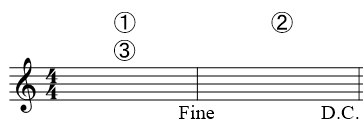今回は反復記号(リピート記号)について説明します
反復記号は、楽譜の中でもよく使われるポピュラーな記号です。
同じメロディーを繰り返すときに、同じ小節を何度も書いていては楽譜が長くなり、見づらくなります。
例えばJ-POPで1番と2番が同じ伴奏だったら、2回書くのは面倒ですよね。
それを解消するためにできたものが反復記号です。
いずれの反復記号も基本的には1度使われると2度目は使いません。
何度も反復していたら曲が終わりませんからね。
もちろん例外もありますので、それを踏まえて解説していきます。
目次
反復記号(リピート記号)一覧
まずは反復記号を一覧で見ていきましょう。
意味と使い方については後述します。
| 番号 | 記号 | 読み方 |
| ① |   | 反復(リピート)記号 |
| ② | 1番括弧 | |
| ③ | 2番括弧 | |
| ④ | ダ・カーポ(Da Capo) | |
| ⑤ | ダル・セーニョ(Dal Segno) | |
| ⑥ | セーニョ | |
| ⑥ | フィーネ | |
| ⑦ | トゥ・コーダ(to Coda) | |
| ⑧ | コーダ |
以上の代表的な8個を説明していきます。
数が多い上に例によって読み方がイタリア語なので、頭に入りにくいですね。
個人で楽しむ分には読み方はあまり重要ではありません。意味をしっかりと覚えましょう。
①反復(リピート)記号
最も一般的なのがこの反復記号です。
ジャンルを問わず、多くの楽譜で使用されています。
覚え方も簡単で、視覚的に分かるようにデザインされています。
意味
| 記号 | 意味 |
 | 前に戻る (特に指示がなければ一番はじめから) |
 | 戻ってきたときはココから |
非常にシンプルですね。
では具体的に楽譜を見て、使い方を確認していきましょう。
使い方
例Ⅰ

反復記号が上図のように配置していた場合は、どのような順番で小節を進んでいけばいいのでしょうか。
答えは下図の順番です。

第2小節に【前に戻る】の反復記号があるため、それに従って戻ります。
この場合特に戻る場所の指示がないため、楽譜の一番始めに戻ります。
1度戻ったら反復記号の役割を終えたので第2小節から第3小節へと進むことができるわけです。
例Ⅱ

今度は戻る位置が指定している場合です。
これもそれほど難しくありません。
答えは下図の順番です。

第2小節に【前に戻る】の反復記号があります。
同じく第2小節に【戻ってきたときはココから】の反復記号があるので、もう一度第2小節を弾きます。
その後、第3小節へと進むわけです。
以上が①の反復記号です。
②1番括弧、③2番括弧
次は②と③を解説します。
これも視覚的に分かるようになっているので、シンプルで難しくありません。
意味
| 記号 | 意味 |
| 他の反復記号で反復するとき1回目だけ、これ以降の小節に進みます。 | |
| 他の反復記号で反復するとき2回目だけ、これ以降の小節に進みます。 |
シンプルなんですが、これだけ見るとよく分かりませんね。
①の反復記号を使いながら例とともに使い方を解説します。
使い方
例

第3小節に①の反復記号が使われていますね。
こちらの答えは
下図の順番です。

1番括弧の小節のあと、反復記号で最初に戻りますが、2回目からは第3小節に行かずに、第2小節から第4小節へと進みます。
まだ視覚的に覚えやすい反復記号ですので、よーく考えれば順番がわかるかと思います。
ちなみに、2番括弧以降も『3番括弧』『4番括弧』、、、、と続く場合があります。(めったにありませんが)
その名の通り、3回目に反復したとき、4回目に反復したとき、、、、と繰り返すだけですので、焦らずに順番を確認するようにしましょう。
④ダ・カーポ(Da Capo)
ここから視覚的には分からなくなります。
算数の九九のように、一度覚えないと対応できませんので、頑張って覚えましょう。
その都度調べていても、自然に覚えるかもしれませんね。
ちなみに「Da」はイタリア語で「~から」、「Capo」はイタリア語で「最初」という意味を持ちますので、そのまま直訳で「最初から」となります。
意味
| 記号 | 意味 |
| 曲の最初に戻る |
これはシンプルです。
これも例によって2回目からは効果がなくなりますので、繰り返すのは1回です。
使い方
例

第2小節の終わりにダ・カーポの記号があります。
答えは下図の順番です。

簡単ですね。
特に説明の必要はないかと思います。
④ダル・セーニョ(Dal Segno)、⑤セーニョ(Segno)
ダル・セーニョは③のダ・カーポと非常に似ているため、間違えやすい記号です。
「Dal」はイタリア語で「~から」(③の「Da」と同じ意味)、「Segno」はイタリア語で「目印」という意味です。
そのまま直訳で「目印から」という意味になります。
同じく⑤のセーニョも同じ綴りですので「目印」という意味です。
意味
| 記号 | 意味 |
| セーニョに戻る | |
| ダルセーニョからここにくる |
イタリア語の意味が分かればシンプルですね。
またまた、例によって2回目からは効果がなくなりますので、繰り返すのは1回ですのでご注意ください。
使い方
例

第2小節の終わりにダル・セーニョの記号があります。
また第2小節の最初にセーニョがあります。
答えは下図の順番です。

またまた簡単ですね。
特に説明の必要はないかと思います。
⑥Fine(フィーネ)
名前は「フィーネ」です。英語の「ファイン」ではないので注意してください。
これ自体は反復の意味を持つ記号ではないのですが、反復記号と一緒に使われるので、覚えておきましょう。
意味
| 記号 | 意味 |
または
| (反復記号で繰り返したあと)ここで曲を終わる |
意味はシンプルですが、イタリア語なので馴染みがないですね。
英語で言うところの「Finish」です。
映画の最後に「fin」と書いてあることがありますが、あれはフランス語で「終わり」という意味です。
どれもラテン語の「finere」が変化したものです。
使い方
例

第2小節の終わりに④のダ・カーポの記号があります。
④をおさらいしながら考えてみましょう。
答えは下図です。

特に説明の必要はないかと思います。
実際にはこんな楽譜はないでしょうが、、、
間違って④で第2小節に行かないようにしましょう。
⑦トゥ・コーダ(to Coda)、⑧コーダ(Coda)
イタリア語の意味は「しっぽ、結尾」という意味です。
少し複雑なので注意しましょう。
意味
| 記号 | 意味 |
| (反復記号で繰り返したあと)ここからコーダの位置まで飛ぶ | |
| トゥ・コーダからここにくる |
飛ぶと表現しましたが、ワープするといったところでしょうか。
実際に使い方を見たほうが速いかもしれません。
使い方
例

先程と同じく第2小節の終わりに④のダ・カーポの記号があります。
答えは下図です。

一度ダ・カーポで最初に戻ったあと、⑦トゥ・コーダがありますので、第1小節から第3小節の⑧コーダの位置へ飛びます。
コメントを残す